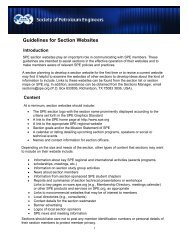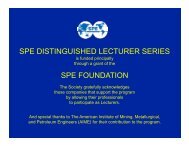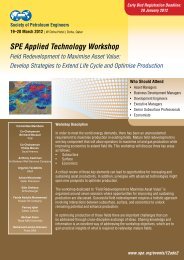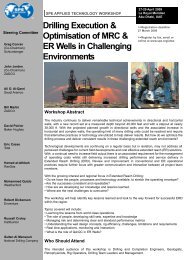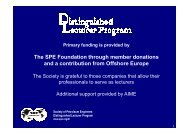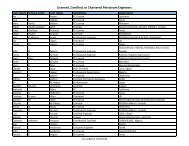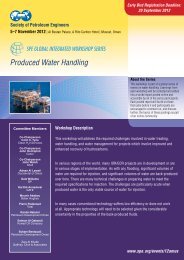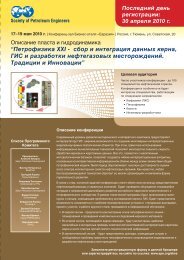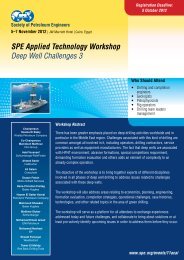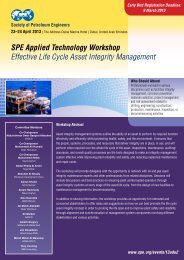Day 1 - Society of Petroleum Engineers
Day 1 - Society of Petroleum Engineers
Day 1 - Society of Petroleum Engineers
Create successful ePaper yourself
Turn your PDF publications into a flip-book with our unique Google optimized e-Paper software.
24<br />
SPE TODAY<br />
Around the Exhibit Floor<br />
A roundup <strong>of</strong> technology being showcased at this year’s ATCE<br />
New Schlumberger Scanner<br />
Offers Continuous Logs Onsite<br />
The Schlumberger Litho Scanner is the<br />
latest member <strong>of</strong> the scanner family <strong>of</strong><br />
wireline tools providing formation and<br />
reservoir data at the wellsite.<br />
With its accurate mineralogical<br />
description and total organic<br />
carbon (TOC) determination,<br />
the measurement is perfect for<br />
evaluation <strong>of</strong> unconventional<br />
reservoirs. Its standalone<br />
quantitative determination <strong>of</strong> TOC<br />
is independent <strong>of</strong> the environment<br />
and the reservoir. Replacing<br />
indeterminate TOC estimations<br />
caused by variations in methodologies<br />
and attempts to combine log and<br />
laboratory information, the new<br />
measurement provides a continuous<br />
log at the wellsite <strong>of</strong> elemental<br />
concentration as well as accurate<br />
mineralogical determination.<br />
Using sCore lith<strong>of</strong>acies classification,<br />
operators can determine optimal<br />
completion intervals from a<br />
combination <strong>of</strong> mineralogy, TOC<br />
concentration, and in-situ stress values.<br />
Booth 1735.<br />
Pheno Seal, Super-Sweep<br />
Provide Wellbore Remedies<br />
Forta Corporation’s Pheno Seal is a<br />
lost-circulation material that is made<br />
from waste-stream high-density<br />
laminate. The seal flakes provide an<br />
efficient shape and a hard, durable<br />
backbone that functions as a bridging<br />
agent to control fracture losses. It can<br />
be used in all water, oil, and syntheticbased<br />
fluids.<br />
Forta’s Super-Sweep fiber is a<br />
hole-cleaning agent for suspending<br />
and transporting solids from the<br />
wellbore. The fiber is an alternative<br />
to conventional gels and polymers for<br />
cleaning the cuttings or millings from<br />
a wellbore when drilling or milling. A<br />
small concentration <strong>of</strong> fiber added to<br />
any drilling fluid will suspend, lift, and<br />
collect wellbore debris. Booth 442.<br />
Diffusion Bonding Strengthens<br />
Mesh and Creates Laminates<br />
G Bopp sintered (diffusion-bonded)<br />
wire mesh sintering combines multiple<br />
layers to provide structural strength<br />
to an otherwise flimsy fine mesh<br />
or to create laminates with specific<br />
physical properties.<br />
Sintering takes place in a controlledatmosphere<br />
furnace with some<br />
degree <strong>of</strong> isostatic pressure and<br />
bonds all wire crossover points within<br />
a single layer. Sintered wire cloths<br />
produced this way yield fine filtration<br />
results and are also resistant to<br />
physical loading, thanks to the robust<br />
mesh structure.<br />
Bopp can sinter any combination<br />
<strong>of</strong> mesh together to achieve physical<br />
properties such as mechanical<br />
strength, controlled permeability,<br />
porosity, thickness, absolute aperture<br />
size, filter fineness, flow rate, and<br />
backwash properties. Booth 1334.<br />
Weatherford Uses RFID<br />
To Actuate Downhole Tools<br />
Radio frequency identification (RFID)<br />
technology has been used successfully<br />
The RipTide RFID reamer is one<br />
<strong>of</strong> the pieces <strong>of</strong> radio frequency<br />
identification technology that<br />
Weatherford has on display during<br />
the exhibition. Photo courtesy <strong>of</strong><br />
Weatherford.<br />
for many years. Weatherford was<br />
an early pioneer <strong>of</strong> this technology<br />
in common oilfield applications to<br />
actuate downhole tools electronically.<br />
With the recent acquisition <strong>of</strong><br />
Petrowell, the company has expanded<br />
its portfolio <strong>of</strong> RFID capabilities<br />
and has broad intellectual property<br />
for the downhole application <strong>of</strong><br />
this technology.<br />
RFID technology is used to activate<br />
downhole tools, track assets, and<br />
enhance completions operations. The<br />
technology helps improve reservoir<br />
management by optimizing well design<br />
and performance. Additionally, RFID<br />
allows multiple tools to be run in the<br />
drillstring and activated or deactivated<br />
on demand, providing opportunities<br />
to improve borehole integrity to<br />
planned depth.<br />
Weatherford is displaying several<br />
<strong>of</strong> its RFID-enabled technologies,<br />
including the RipTide RFID reamer,<br />
which has been applied in various<br />
operations worldwide. Booth 1951.<br />
XML-Based Standards Simplify<br />
Upstream Data Management<br />
The Energistics Consortium’s PRODML,<br />
WITSML, and RESQML provide<br />
standard XML-based data exchange<br />
standards for upstream operations.<br />
Production Markup Language<br />
(PRODML) is the consortium’s initiative<br />
for open, nonproprietary, standard<br />
interfaces between s<strong>of</strong>tware tools<br />
used to monitor, manage, and optimize<br />
hydrocarbon production in the modern<br />
digital oilfield.<br />
PRODML enables near-real-time<br />
production optimization. It focuses<br />
on the data from the reservoirwellbore<br />
boundary to the custody<br />
transfer point and integration with the<br />
consortium’s other domain standards<br />
such as Wellsite Information Transfer<br />
Standard Markup Language (WITSML)<br />
and the Reservoir Characterization<br />
Markup Language (RESQML).<br />
Booth 1421.<br />
Ingrain Creates Digital Rock<br />
for High-Tech Sample Analysis<br />
Oil and gas exploration is becoming<br />
increasingly dependent on rocks<br />
such as complex carbonates and<br />
shale. To better understand the inner<br />
workings <strong>of</strong> these rocks, however, new<br />
technologies are needed. Houstonbased<br />
Ingrain can accurately determine<br />
the static and dynamic rock physics<br />
properties from reservoir rocks.<br />
Ingrain can also provide information<br />
from drill cuttings from wells not<br />
cored, making full use <strong>of</strong> all available<br />
data and allowing for nanometerscale<br />
observations and better<br />
reservoir characterization.<br />
Using the latest X-ray computed<br />
tomography technology, highresolution<br />
3D pore space can be<br />
imaged in reservoir rocks at a<br />
multitude <strong>of</strong> scales. From these<br />
digital rocks, static and dynamic rock<br />
properties can be computed. As these<br />
tests are not destructive, all <strong>of</strong> the<br />
computations can be repeated on the<br />
same rock sample. Booth 1353.<br />
Swell Meter, Rheometers Face<br />
High Pressures, Temperatures<br />
Grace Instrument’s M4600 highpressure/high-temperature<br />
(HP/HT)<br />
linear swell meter is an automated<br />
dual-core meter that measures<br />
volumetric expansion (or contraction)<br />
<strong>of</strong> a core/wafer sample under<br />
simulated downhole conditions. As it<br />
does this, it saturates the sample with<br />
a drilling fluid.<br />
The meter’s design allows core<br />
samples to expand in only one<br />
direction, allowing repeatable test<br />
results. Quick sample loading and<br />
hardware setup optimize the process. A<br />
dual core/wafer compactor is available<br />
so that drill cuttings or other solids can<br />
be compressed into a self-adhering<br />
core/wafer and tested.<br />
Grace’s M5600 HP/HT rheometer<br />
is a true-Couette, coaxial-cylinder,<br />
rotational, HP/HT rheometer. It is also<br />
available with an optional viscoelastic<br />
module for performing viscoelasticity<br />
tests to derive elastic (G′), viscous<br />
(G″), and complex (G*) moduli and<br />
phase angle.<br />
The meter’s design provides direct<br />
readings inside the pressure vessel<br />
without bob shaft bearings for lower<br />
maintenance costs and continuous<br />
testing <strong>of</strong> corrosive samples. The<br />
rheometer incorporates a direct<br />
drive between the bob shaft and the<br />
torque transducer, which eliminates<br />
momentum-<strong>of</strong>-inertia errors<br />
associated with magnetically coupled<br />
torque transducers. This allows the<br />
torque transducer to respond quickly<br />
and consistently to changing bob<br />
shaft torque.<br />
The company’s M7500 Ultra<br />
HP/HT rheometer is a coaxial<br />
cylinder, rotational, HP/HT rheometer<br />
engineered to measure various<br />
properties <strong>of</strong> fluids (including American<br />
<strong>Petroleum</strong> Institute HP/HT tests) to<br />
30,000 psi and 600°F.<br />
The meter has a thick-walled steel<br />
pressure cell surrounded by a fail-safe<br />
steel containment vessel to ensure<br />
operator safety. It is designed for easy<br />
test setup, sample loading, and posttest<br />
cleaning. Booth 2021.<br />
Reservoir Data Modeling<br />
Suite Enlightens Drillers<br />
Paradigm’s advanced SKUA, Geolog,<br />
and Sysdrill applications together <strong>of</strong>fer<br />
geophysicists, geologists, and drilling<br />
engineers increased efficiency, reduced<br />
drilling uncertainty and risk, and<br />
faster decision-making on the basis <strong>of</strong><br />
accurate and realistic models.<br />
Geolog 7 is the next-generation<br />
version <strong>of</strong> the Geolog Formation<br />
Evaluation suite. Geolog is<br />
customizable to specific user<br />
requirements; the modular design<br />
provides a flexible s<strong>of</strong>tware<br />
environment that can be scaled from<br />
a single user on a laptop to a team<br />
collaborating over the network. Version<br />
7 combines the system’s technological<br />
superiority with a modern, userfriendly<br />
interface that is consistent<br />
across multiple platforms and provides<br />
enhanced efficiency and usability.<br />
Geolog Geosteer enables the<br />
geosteering expert to merge data<br />
from existing wells and interpreted<br />
surfaces to build 3D log property<br />
models, which are used to forwardmodel<br />
anticipated logging-whiledrilling<br />
log responses along planned<br />
high-angle or horizontal wellbore<br />
paths. Correlation <strong>of</strong> the predicted logs<br />
with actual logs acquired during drilling<br />
allows the user to accurately determine<br />
the stratigraphic position <strong>of</strong> the well.<br />
Booth 1420.<br />
Paradigm’s Geolog Formation Evaluation s<strong>of</strong>tware suite provides a consistent<br />
interface across multiple platforms. Photo courtesy <strong>of</strong> Paradigm.





